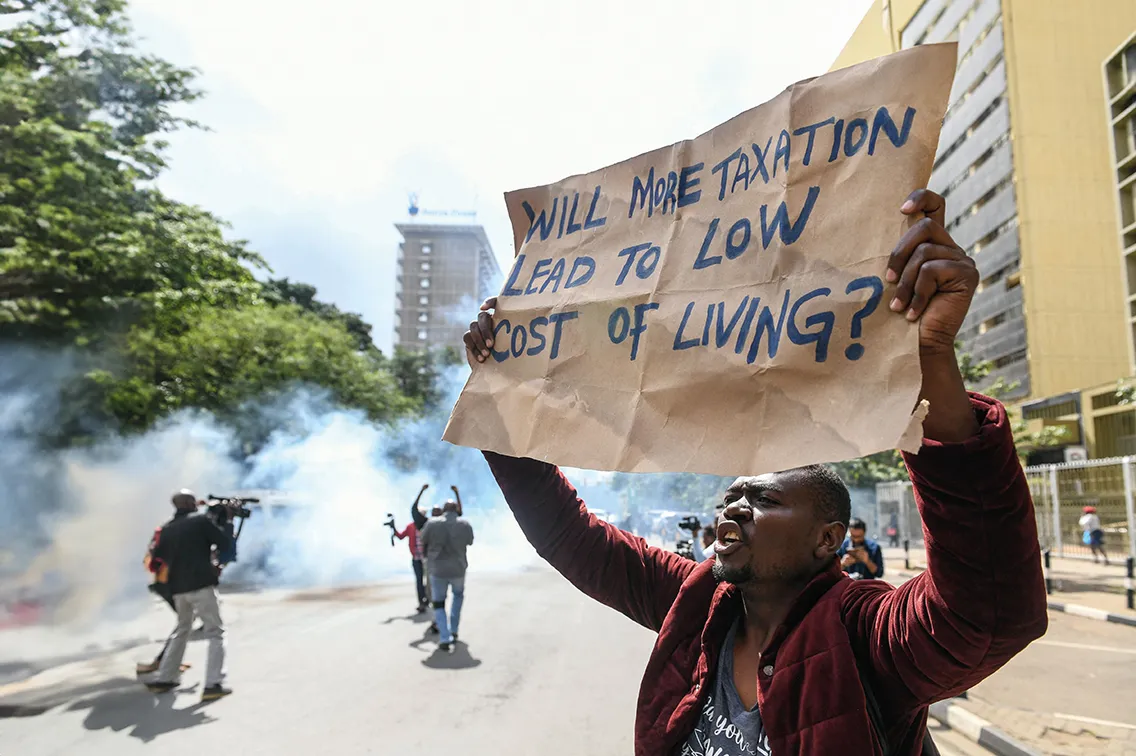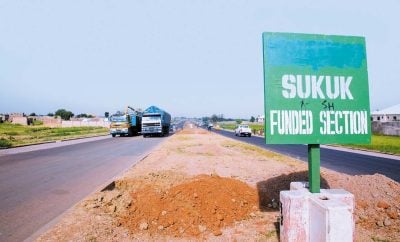
Weeks after the waves of fierce anti-tax protests that rocked Kenya’s capital and other major cities in June and July this year, an uneasy calm has settled in place of the recent chaos in Nairobi’s bustling streets.
Burnt-out vehicles and looted and damaged shops remain as stark reminders of President William Ruto’s ambitious economic reforms, once hailed by the International Monetary Fund (IMF) as the path to fiscal stability, but now facing a crucible of public resentment and political upheaval.
The protests, initially sparked by the introduction of a controversial finance bill, have snowballed into a wider expression of frustration over the rising cost of living. As the demonstrations continue (at the time of writing), they threaten to derail Kenya’s delicate dance with the IMF and send foreign borrowing costs soaring, potentially plunging the East African economic powerhouse into a fiscal crisis.
President Ruto, who came to power in 2022 on a platform of economic revitalisation, inherited an economy burdened by debt and struggling with the aftermath of the pandemic. But his administration’s attempts to increase tax revenue and reduce the budget deficit have collided head-on with a population already stretched thin by unemployment, inflation and economic hardship.
The proposed finance bill, which came amid calls for the scrapping of a controversial housing levy introduced last year, contained a range of new taxes that have become the focal point of public fury.
They included a 16% sales tax on bread, a 25% duty on cooking oil, a vehicle ownership tax amounting to 2.5% of the value of the vehicle, an eco levy that raises the price of sanitary pads, nappies, mobile phones and media equipment, and a 16% tax on goods and services in the construction and health industries. The proposed bill also aimed to increase general import tax to 3% of product value.
While the government insists they are necessary to put Kenya on a sustainable fiscal path and meet IMF targets, Kenyans argue the measures disproportionately affect the poor and middle class, and they have consequently resulted in the deadliest anti-tax protests in the history of the country.
What began as sporadic and peaceful demonstrations in Nairobi under the X hashtag #RejectFinanceBill2024 in June, quickly spread across the country, with protests happening in the rural counties. Unlike previous demonstrations, this year’s protests are leaderless and coordinated from X, TikTok and WhatsApp, with the government finding it difficult to counter them.
Parliament burned down
To try to calm the pressure from angry citizens who burned down parliament on 25 June after legislators passed the bill, President Ruto (below) rejected it, avoiding signing it into law, and forcing the treasury to create a supplementary budget instead. That did little to appease irate Kenyans, who voiced their concerns over wanton embezzlement of public resources by government officials, and Ruto’s tolerance of corruption and poor service delivery, especially by the health, agriculture, transport and education ministries.
As the protests intensified, Ruto fired his entire cabinet on 11 July and the inspector general of police the next day. This measure, ostensibly aimed at reshuffling his team to better address the crisis, was interpreted by many as a sign of panic within the government. On 19 July, he named the first batch of his new cabinet, but his reappointment of six of the ministers he had sacked reignited public anger. This resulted in protests near the Jomo Kenyatta International Aiport that paralysed air travel on 23 July.
According to data from the Kenya National Commission of Human Rights (KNCHR), there have been 50 deaths and 413 serious injuries to date, while 682 people have been arbitrarily detained and 59 have been abducted or are missing in connection with the protests.
“We cannot afford to eat, and now they want us to pay more taxes,” Jane Muthoni, a small business owner in Nairobi’s Kibera slum, told African Banker. “How are we supposed to survive?” Her sentiments echo throughout the crowds, who have been protesting every Tuesday, and now economic grievances mingle with political frustrations.
“What pains me most is that money collected through taxation and that was borrowed from the IMF and World Bank goes into the pockets of senior government officials and politicians,” Alex Tanui, an economics student at Multimedia University in Nairobi, told this writer. Kenya ranked 126th among 180 countries in Transparency International’s 2023 Corruption Perceptions Index. Former president Uhuru Kenyatta revealed in 2021 that the country loses $15m every day to graft.
The immediate economic impact of the protests has been severe. The Nairobi Securities Exchange (NSE) has seen significant volatility, with foreign investors growing increasingly wary.
On 4 July, NSE reported a loss of about $600m in investor wealth in two weeks due to the protests, which had seen businesses looted by protesters. The Kenyan shilling, which has exhibited resilience, is now under pressure and has weakened against major currencies, plunging from 127.18 against the US dollar on 6 July to 132.5 on 23 July, exacerbating inflationary pressures.
Tourism, a key foreign exchange earner, has taken a hit as images of unrest circulate globally. “We’ve seen a 40% cancellation rate in the past week,” says John Musau, CEO of a Nairobi-based tour firm. “If this continues, the impact on our industry will be devastating.”
The protests have also disrupted supply chains, with roadblocks and security concerns hampering the transport of goods and delivery of services. This has led to shortages and price spikes in some areas, further fuelling public discontent.
IMF targets in jeopardy
In the protests, placards denouncing the IMF and World Bank were raised, accusing them of causing the crisis. “IMF, World Bank, Stop Modern Day Slavery,” they read.
Kenya’s $2.34bn Extended Fund Facility and Extended Credit Facility arrangements with the IMF, agreed upon in 2021, were designed to support the country’s Covid-19 response and reduce debt vulnerabilities. However, the current unrest threatens to derail these carefully negotiated targets.
Kenya’s debt pressures spurred the IMF to approve $941m for the country in January, bringing the total amount loaned to the East African nation by the financial agency to $3.9bn. A separate climate fund was also approved at $542m. But interest payments on Kenya’s debt have been eating up almost 38% of annual revenues, according to the World Bank.
The IMF’s loan conditions included raising taxes, reducing subsidies, and cutting government waste – measures aimed at increasing government revenue while curbing spending. These initiatives began last year, with Ruto prioritising the IMF programme.
After taking office in September 2022, Ruto, himself one of the richest businessmen in the country, suspended subsidies on fuel and fertilisers as part of the IMF programme. However, fuel subsidies were reinstated in 2023 following widespread protests.
The IMF also backed the Finance Bill 2023, which was passed and signed into law. This bill introduced a 2.5% housing levy for employed individuals and doubled the VAT on fuel from 8% to 16%. Protests erupted against the bill last year, but the turnout was not as high as the protests seen this year.
The now-withdrawn Finance Bill 2024, also supported by the IMF, with its proposed tax hikes, was expected to generate $2.7bn to address a budget deficit and fund development programmes. Analysts indicated that Kenya still needs to address this gap to meet some targets under the IMF programme.
Kenya, which has never defaulted, issued new debt in February at a steep borrowing cost of 10%, alleviating fears it might follow defaults by Ethiopia, Ghana, and Zambia. Before the protests, the IMF stressed the need for Kenya to make “a sizeable fiscal adjustment” and praised the controversial tax increase. The IMF loans helped Kenya avoid defaulting on a $2bn Eurobond that matured in June.
The IMF’s latest review, conducted just weeks before the protests erupted, had hailed Kenya’s progress. However, the fund also warned of the challenges ahead, particularly in terms of revenue collection.
With the finance bill now in limbo, Kenya faces the prospect of missing its fiscal targets, possibly jeopardising future disbursements under the programme. “When the IMF gives you conditions, you don’t need to pass on the bulk to the people when you know the situation in your country,” notes Dumebi Oluwole, an economist with data intelligence firm Stears.
On 26 June, the IMF released a statement expressing concern about the developments. “We are deeply concerned about the tragic events in Kenya in recent days and saddened by the loss of lives and the many injuries,” it said. “Our main goal in supporting Kenya is to help it overcome the difficult economic challenges it faces.”
As uncertainty mounts, Kenya’s borrowing costs in international markets have spiked. The yield on Kenya’s Eurobonds has risen sharply, reflecting investors’ growing unease about the country’s fiscal trajectory and political stability.
“We’re seeing a significant risk premium being applied to Kenyan debt,” notes Kennedy Oginga, a bank manager of a local bank. “This could make it prohibitively expensive for Kenya to access international capital markets in the near term.”
The increased borrowing costs come at a particularly inopportune time for Kenya, which faces significant external debt repayments in the coming years. The country’s debt-to-GDP ratio, already high at around 67%, could climb further if the government is forced to borrow at higher rates to meet its obligations.
Local banks, traditionally significant holders of government debt, are also reassessing their positions. “We’re seeing a shift in risk appetite,” says Oginga. “There’s growing concern about the government’s ability to implement its fiscal plans, which is pushing up yields on domestic bonds as well.”
What next for Kenya?
President Ruto, despite his initial hardline stance, has shown signs of flexibility and even being open to an inclusive government with Ministers drawn from the opposition.
“I assure Kenyans that I will have a very effective Cabinet to serve Kenyans. We create jobs, we manage our debts, we deal firmly and decisively with corruption and make sure Kenya marches forward,” he said.
Kenya’s international partners are watching developments with growing concern. The United Nations, the United States, the European Union and 13 embassies have called for restraint on all sides, emphasising the importance of peaceful dialogue.
The UN Secretary General, António Guterres, said he was “deeply saddened by the reports of deaths and injuries”, including of journalists and medical personnel connected to protests. “I urge the Kenyan authorities to exercise restraint and call for all demonstrations to occur peacefully,” Guterres added.
Want to continue reading? Subscribe today.
You've read all your free articles for this month! Subscribe now to enjoy full access to our content.
Digital Monthly
£8.00 / month
Receive full unlimited access to our articles, opinions, podcasts and more.
Digital Yearly
£70.00 / year
Our best value offer - save £26 and gain access to all of our digital content for an entire year!

 Sign in with Google
Sign in with Google 



